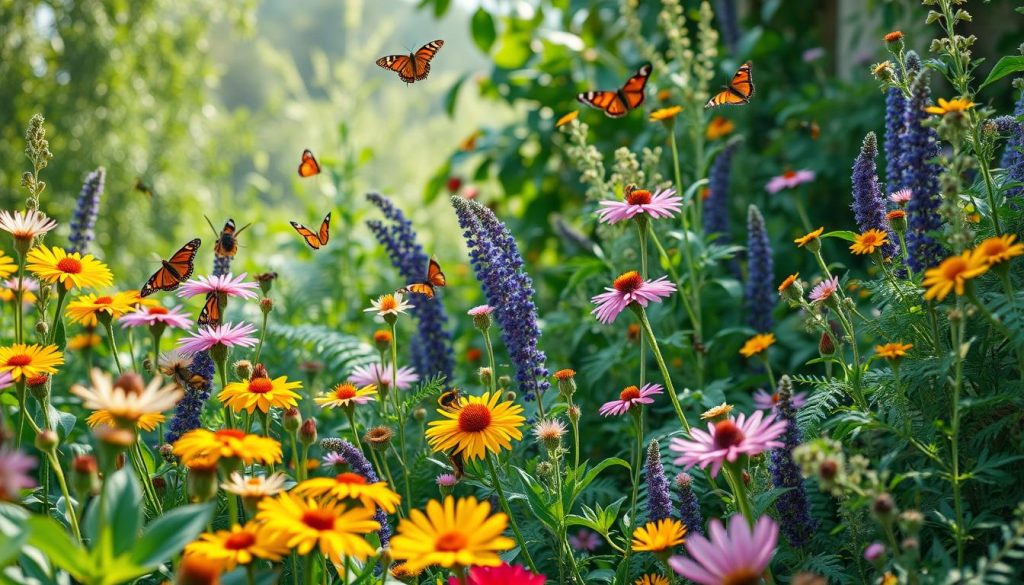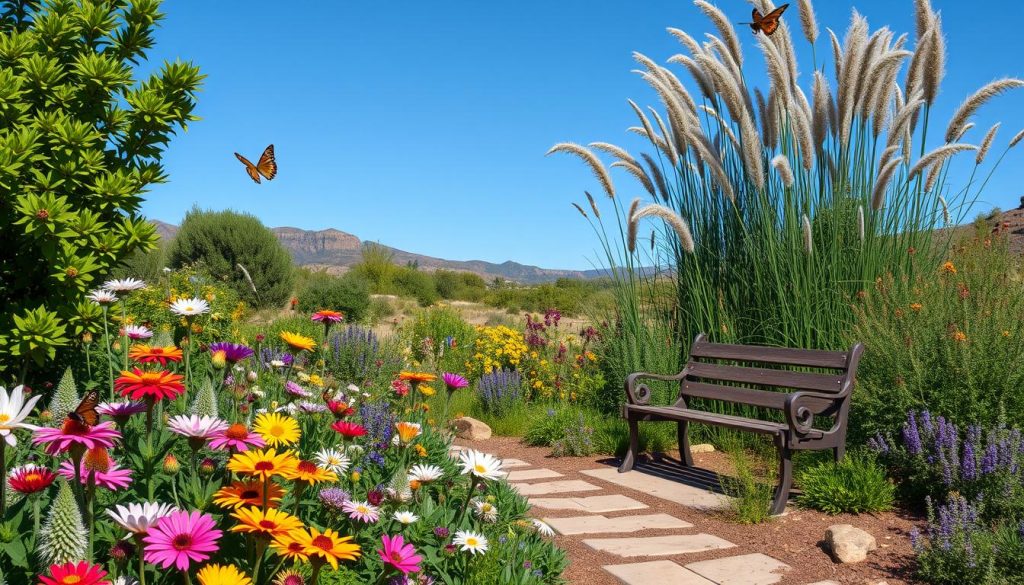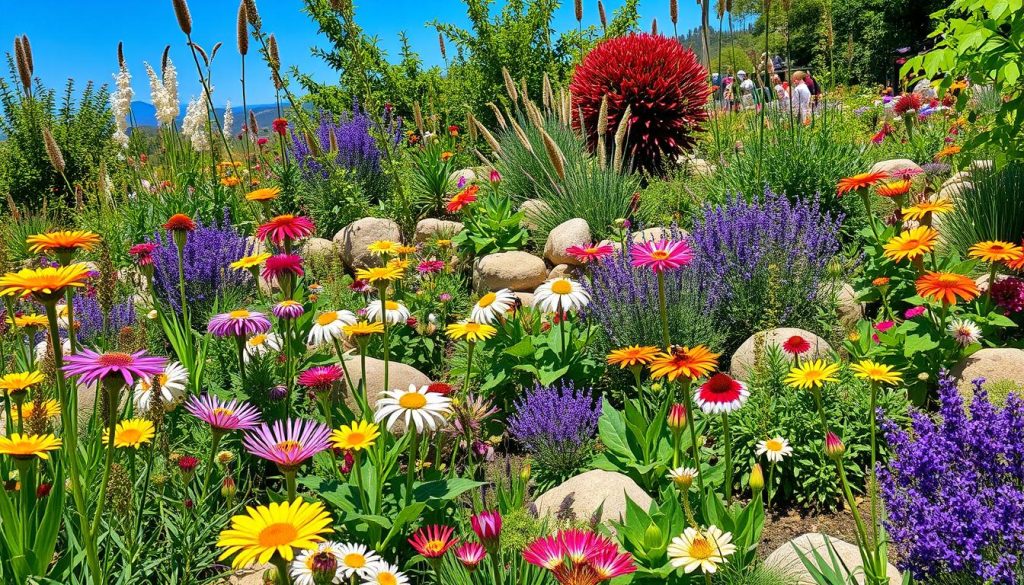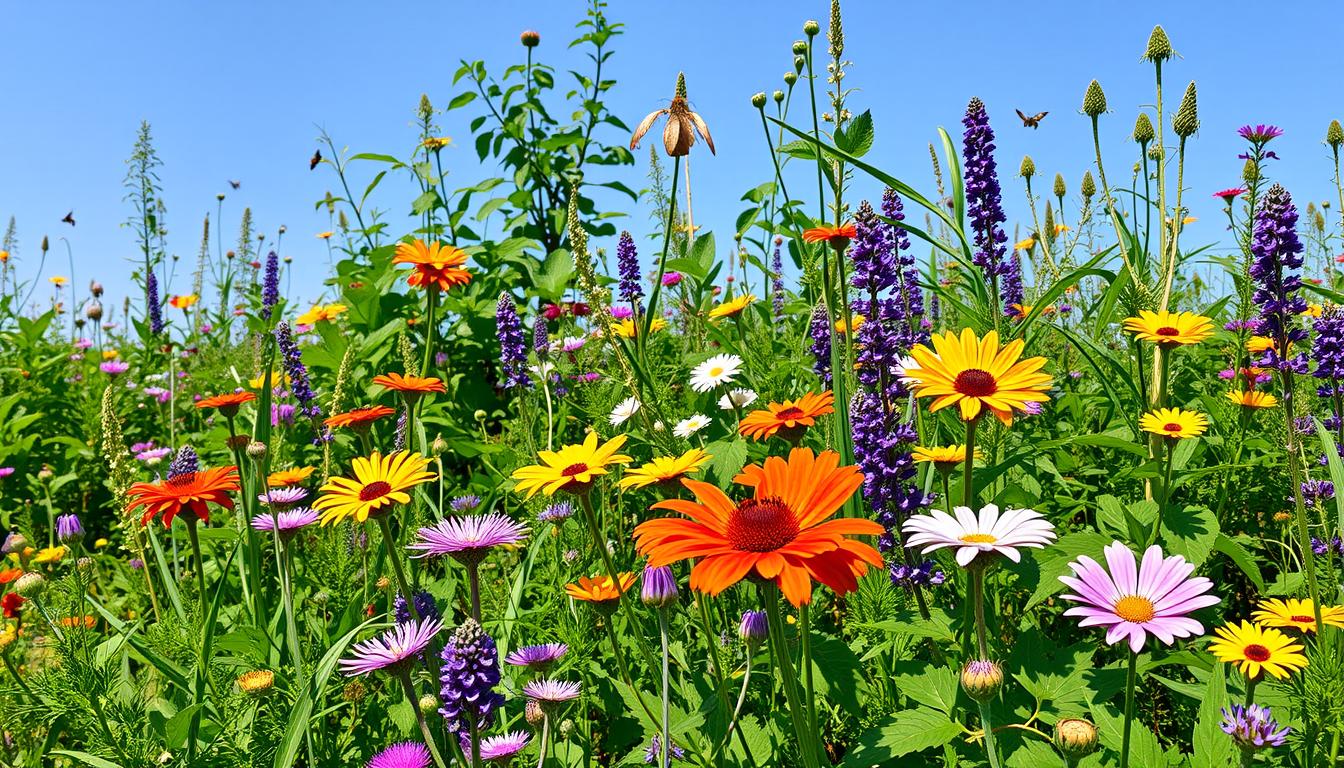I’m excited to share my journey of creating a sustainable garden. I’ve learned that native plants are key for a healthy environment. The United States Environmental Protection Agency (EPA) agrees.
Native plants fit well with our local climate and soil. They need less water, fertilizers, and pesticides. This makes them great for an eco-friendly garden.
Native plants bring many benefits to my garden. They attract pollinators and need less care. In this guide, I’ll share my experiences and tips for growing native plants.
Understanding the Importance of Native Plants
Exploring native plants has opened my eyes to their role in a sustainable garden. These plants have grown alongside local wildlife, offering food and shelter. This partnership is key to a healthy ecosystem. By adding native plants to our gardens, we help biodiversity and attract pollinators, vital for our environment’s health.
Native plants offer many advantages. They need less care and help prevent soil erosion. They also support local wildlife, making our gardens vibrant ecosystems. Some main benefits include:
- Providing food and shelter for local wildlife
- Supporting pollinators and biodiversity
- Requiring less maintenance and care
- Helping to prevent soil erosion
Choosing native plants for our gardens benefits local wildlife and our ecosystem’s health. Next, we’ll look at picking the right native plants for our area and preparing our garden for them.

Choosing the Right Native Plants for Your Area
Creating a native plant garden starts with picking the right plants. I want to choose the best native plants for my garden, and I’m sure you do too. First, I research local plants to find out which ones are native to my region. I look at the USDA Plant Hardiness Zone Map to see which plants are good for my area.
Native plant landscaping ideas come from the beauty of local flora. By picking plants native to my area, I can make a garden that’s beautiful, sustainable, and good for the environment. Some tips for designing a native plant garden include choosing plants that attract pollinators and provide interest all year.
Researching Local Flora
Researching local flora is key to creating a native plant garden. I look at the types of plants native to my area and pick the ones that will do well in my garden. I use online resources or talk to local nurseries to learn more about local flora.
Consulting Native Plant Societies
Getting advice from native plant societies is also helpful. These groups know a lot about native plants and can give great advice on which plants will work best in my garden. They may also have plant lists, gardening tips, and workshops to help me start.

By following these tips and doing my research, I can make a beautiful and sustainable native plant garden. It will attract pollinators and be interesting all year. Whether you’re starting or updating your garden, creating a native plant garden is a great way to connect with nature and support the local ecosystem.
Preparing Your Garden for Native Plants
To make a native plant garden thrive, preparing your garden is key. I’ve found that checking the soil is a must. Soil tests show the pH and nutrients, helping pick the right plants. This way, I help my garden and the local ecosystem.
Preparing my garden means thinking about how native plants will grow. Here are important things to remember:
- Checking the soil’s pH and nutrients
- Figuring out the plants’ sunlight and water needs
- Improving the soil for native plants to do well
By using these tips, I can make a stunning garden. It shows the value of native plants.

Native plants fit our local climate and soil perfectly. They need less fertilizer, pesticides, and water. This makes my garden better for the environment. Native plants are essential for a natural, beautiful garden ecosystem.
| Native Plant | Soil Conditions | Sunlight Needs | Water Needs |
|---|---|---|---|
| Butterfly Weed | Well-draining soil | Full sun | Low water |
| Black-eyed Susan | Medium soil | Full sun to partial shade | Medium water |
| Blazing Star | Moist soil | Full sun to partial shade | High water |
Best Practices for Planting Native Species
Exploring native plants for sustainable gardens has shown me the value of proper planting. Timing is key for eco-friendly landscaping. Planting in the fall or early spring helps native plants grow strong roots before summer.
Understanding the basics of native planting is crucial. This includes knowing the right depth and spacing for each plant. With research and planning, you can create a stunning garden that highlights native plants.
Native Planting Techniques
- Plant native species at the correct depth to ensure proper root growth
- Space plants appropriately to allow for air circulation and sunlight penetration
- Use mulch to retain moisture and suppress weeds
Companion Planting with Native Species
Companion planting boosts your garden’s beauty and biodiversity. Pairing native plants with others creates a thriving ecosystem. This approach benefits the environment and adds visual interest to your garden.

Maintaining a Sustainable Native Garden
To keep my native garden thriving, I’ve learned to adopt sustainable gardening tips with native plants. Watering is key, and I do it efficiently to save water. I collect rainwater in a barrel to cut down on water use. This helps the environment and saves money on my water bill.
For fertilizing, I choose compost. It’s full of nutrients and makes the soil healthier. This natural method avoids synthetic fertilizers, creating a balanced ecosystem. By following these tips, my garden stays healthy and vibrant. Here are some native plant landscaping ideas:
- Choose native plants that fight off pests and diseases, cutting down on pesticides and fertilizers.
- Use natural predators like ladybugs or lacewings to control pests, which eat common garden pests.
- Try organic pest control like neem oil or insecticidal soap to protect beneficial insects.
By using these strategies, I’ve made a sustainable native garden. It’s good for the environment and a beautiful place to relax.
Watering and Fertilizing Tips
Watering and fertilizing are key to a sustainable native garden. Using rainwater and compost reduces environmental impact and promotes healthy plants.
Pest Management Solutions
Effective pest management is vital for a thriving native garden. Natural predators and organic pest control methods help keep beneficial insects safe and maintain balance.
Seasonal Changes and Your Native Garden
As a native plant lover, I know how key it is to adjust garden care with the seasons. Native plants help create a lively and diverse ecosystem. By adding native plants to your garden, it stays vibrant and strong all year.
Native plants are built for local weather and can handle harsh conditions. Yet, it’s important to change your care based on the seasons. For instance, in summer, they might need more water. In winter, they need protection from cold.
Adapting Care with the Seasons
To care for your native garden through the seasons, follow these tips:
- Change your watering schedule with the season
- Fertilize your plants when they’re growing
- Shield your plants from extreme weather, like frost and heatwaves
Understanding Dormancy in Native Plants
Some native plants sleep through winter, stopping growth and saving energy. Knowing about dormancy helps you care for them right. By choosing native plants and adjusting your care, you’ll have a stunning garden that supports local wildlife.
| Season | Native Plant Care Tips |
|---|---|
| Spring | Water regularly, fertilize, and prune plants as needed |
| Summer | Water often, give shade to sensitive plants, and control weeds |
| Autumn | Water less, add mulch to keep moisture, and plant new species |
| Winter | Protect from frost, water less, and support plants that need it |
Creating a Pollinator-Friendly Environment
I’m working on making my native garden a haven for pollinators. By picking native plants, I help bees and butterflies. These insects are key for plants to grow and for the ecosystem’s health.
Native plants are great for pollinators. They’ve grown with local bees and butterflies. They offer nectar and pollen, attracting these important insects to my garden.
Importance of Pollinators
Pollinators are crucial for our ecosystem’s health. Without them, many plants can’t reproduce. This would hurt our food supply. By supporting pollinators, I help my garden thrive and contribute to their conservation.
Native Plants that Attract Pollinators
Here are some native plants that draw in pollinators:
- Butterfly Weed (Asclepias tuberosa)
- Bee Balm (Monarda didyma)
- Black-eyed Susan (Rudbeckia hirta)
- Purple Coneflower (Echinacea purpurea)
Adding these plants to my garden will make it a pollinator paradise. It will also make my garden sustainable and healthy. I’m excited to see how it will benefit my garden and the environment.
Invasive Species to Avoid
As I care for my native garden, I’ve learned the value of native plants. They are key to a healthy garden ecosystem. Invasive species can harm native plants, reducing biodiversity. It’s important to avoid these species and know how to manage them.
Invasive species are plants, animals, or insects that harm native ecosystems. They compete with native species for resources, leading to a decline in their numbers. For instance, plants like kudzu and English ivy can smother native plants. Insects like the emerald ash borer can kill native trees.
Identifying Problematic Non-Natives
How do you spot invasive species in your garden? Here are some common ones to watch out for:
- Kudzu
- English ivy
- Japanese stiltgrass
- Autumn olive
These plants can be hard to control once they spread. It’s crucial to remove them early to prevent further growth.
Strategies for Managing Invasives
Once you’ve found invasive species, it’s time to manage them. Here are some strategies:
- Physical removal: Pulling or digging up invasive plants can be an effective way to control them.
- Herbicides: In some cases, herbicides may be necessary to control invasive plants. However, be sure to use them responsibly and follow all safety guidelines.
- Replacement with native species: Once you’ve removed invasive plants, replace them with native species that will thrive in your garden’s conditions.
By following these steps, you can protect your garden from invasive species. This helps maintain biodiversity. Remember, native plants are vital for a healthy garden ecosystem.
Resources for Native Plant Enthusiasts
Exploring native plants has opened up a world of knowledge for me. I’ve found many resources like books, online guides, and local workshops. These help me learn more about native plant landscaping ideas. It’s fun and rewarding to create a sustainable garden with the right tools.
Groups like the Lady Bird Johnson Wildflower Center and the Native Plant Society are great for learning. They provide guides, webinars, and workshops. These resources help me understand how to use native plants in my garden.
Recommended Resources
- Books: “Native Plants for Your Garden” and “The New Seed Starter’s Handbook”
- Online Guides: The Lady Bird Johnson Wildflower Center and the Native Plant Society websites
- Local Workshops and Community Events: Check with local nurseries, gardening clubs, and conservation organizations for upcoming events
Meeting other native plant lovers has enriched my knowledge. I’ve learned a lot from their experiences. Whether you’re new or experienced, there’s help available to make your garden beautiful and sustainable.
Celebrating Your Native Garden
As you’ve cared for your native garden, you’ve seen amazing changes. These changes help the local ecosystem. Now, it’s time to show your garden to others and help with native plant conservation.
Sharing Your Success with the Community
Showing off your garden can inspire others to use native plants. You might want to host an open house or join local gardening events. Social media is also great for sharing your garden’s beauty and why native plants are important.
Getting Involved in Native Plant Conservation
Helping with native plant conservation is key to protecting our ecosystems. Look for opportunities to volunteer with local groups. You can help with seed collection, habitat restoration, or teaching others. This way, you’ll help the cause and learn more about native plants and animals.
Every native garden is a big step towards a better future. By sharing your love for gardening and helping with conservation, you can encourage others. Together, we can make the world greener and more diverse.

